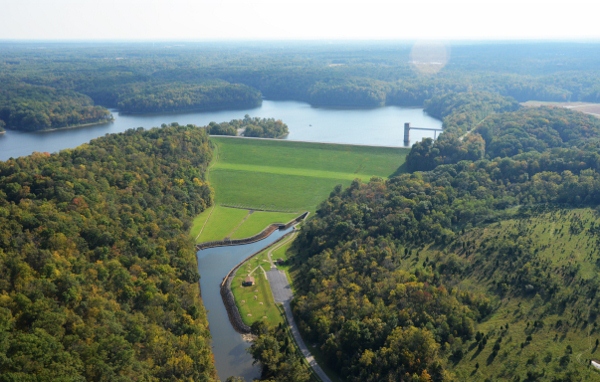
2185 Slade Road
Batavia, OH 45103-9707
Telephone 513-797-6081
Office hours: M-F, 7:30 a.m. - 3:30 p.m. (may vary, call ahead)
Office hours: Sat.-Sun., 7:30 a.m. - 4:00 p.m Spring and Fall (may vary, call ahead)
Office hours: Sat.-Sun., 7:30 a.m. - 4:30 p.m. Memorial Day through Labor Day (may vary, call ahead)
Lake Elevation Lake Temperature
Area weather: Current weather conditions for Batavia, Ohio.
Please visit our Facebook page by clicking here.
To learn about William H. Harsha Lake recreation, click here.
Location
Welcome to the William H. Harsha Lake (also known as East Fork) website. The lake is situated in Clermont County in southwestern Ohio, about 25 miles east of Cincinnati. The dam is about four miles south of Batavia, Ohio, on the East Fork of the Little Miami River.
William H. Harsha exists as a cooperative management effort between the Corps of Engineers and the Ohio Department of Natural Resources - Divisions of Parks and Recreation, Watercraft, and Wildlife. A variety of other partnerships play important roles in the management of the 10,000 plus acres of public lands at William H. Harsha Lake.
Authorization
William H. Harsha Lake was authorized under the Flood Control Act of 1938. The Louisville District of the U.S. Army Corps of Engineers designed, built, and operates the project to reduce flood damages downstream from the dam.
During the fall and winter months, when excessive rainfall is likely, the lake is kept at a lower level referred to as winter pool. Should heavy rains occur, surface water runoff is stored in the lake until the swollen streams and rivers below the dam have receded and can handle the release of the stored water without damage to lives or property.
History
William H. Harsha, for whom this lake is named, was born in Portsmouth, Ohio. He was graduated from Portsmouth High School and earned B.A. and Ph.D degrees from Kenyon College and a Law Degree from Western Reserve University. Mr. Harsha was elected to Congress in 1960 and served until his retirement in January 1981. While in Congress, he served on the Public Works and Transportation Committee, and was the ranking Republican from 1970 to 1981.
William H. Harsha Lake lies within the Little Miami River Basin. The drainage patterns and topography of the region were determined to a large extent by the Kansan, Illinoian, and Wisconsin periods of glaciation. The Illinoian period--estimated to have occurred 300,000 years ago--covered the entire Little Miami Valley, leaving deposits that formed the soils of much of the area. The bedrock formations of the region were formed during two periods of the Paleozoic Age -- the Ordovician Era dating back 360-400 million years and the Silurian Era, which ended 320 million years ago.
In its upper reaches, the East Fork of the Little Miami River meanders through gently rolling country. Below Williamsburg, the valley descends rapidly and for several miles the river flows on bedrock confined within a narrow gorge. The river then enters and continues in a broad deeply-filled valley to its juncture with the Little Miami River near Milford.
In 1869 there were two goldmines within what is now the William H. Harsha Lake project boundaries. One--located on the north bank in the vicinity of Elk Lick--consisted of a flume for the washing of glacial deposits. The other was a tunnel mine in the vicinity of Twin Bridges.
The "Old Bethel Church," located approximately one mile north of Bantam on Elk Lick Road near the park office, was built in 1867. It occupies the site of a log church built about 1807 by Rev. John Collins that was replaced in 1818. The present church is believed to contain some of the hand-hewn timbers secured with wooden pegs and hand-forged nails that remained from the 1818 structure. In the adjacent cemetery are buried many of the original settlers of the area, among whom are John and Sarah Simpson, maternal grandparents of Ulysses S. Grant. The Rev. John Collins and his son, General Richard Collins are also buried there, along with Andrew Pinkham, the sea captain who named the tiny village of Bantam after a small village on the island of Java.
Point Pleasant, a short distance south of William H. Harsha Lake along the Ohio River, is the birth place of Ulysses S. Grant. Born April 27, 1822, Grant was destined to serve his country in war and peace. Graduated from West Point in 1843, he served with distinction during the Mexican War and the Civil War. In 1868, Grant ws elected as the 18th President of the United States and served two full terms. The general died July 23, 1885 at Mount McGregor in the Adirondacks, and was buried in Riverside Park, New York City.
Water Quality
The U.S. Army Corps of Engineers operates William H. Harsha Lake for flood reduction. Between April 1 and May 1, the lake is raised four feet from winter pool elevation of 729 feet mean sea level (msl) to summer pool elevation of 733 feet msl. The lake level is lowered to winter pool elevation from September 1 to December 1. For lake elevation and outflow readings, click here. More information about the current lake elevation can be found on the USGS website.
The quality of the water in William H. Harsha Lake is very important to the U.S. Army Corps of Engineers. Throughout the warmer months, lake personnel gather a temperature and dissolved oxygen profile. Further testing is conducted by other agencies. For more information about water quality in Corps Lakes, go to the Louisville District Water Quality website. It has information on a variety of related topics, including harmful algal blooms, typically referred to as HAB's. HAB's have become a concern recently, and lake personnel gather water samples for further testing whenever an algal bloom is detected. For more information about water quality testing of East Fork State Park's two swimming beaches, click here.